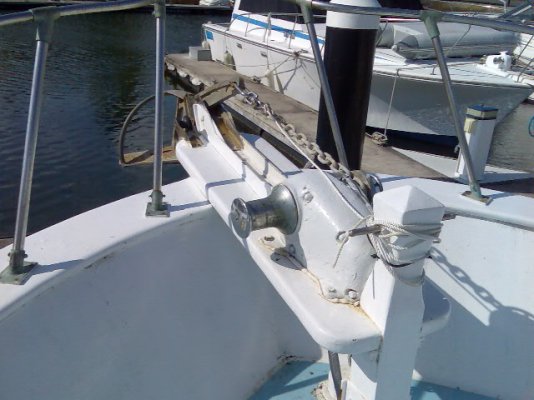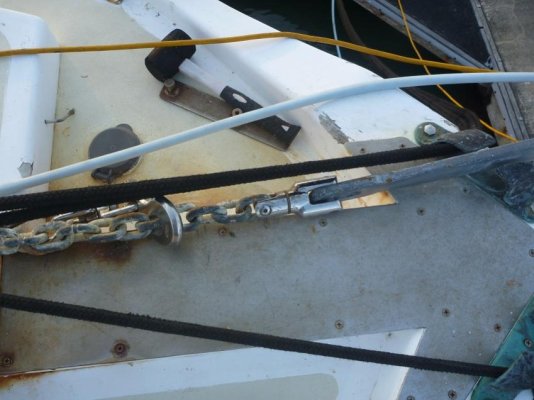- Joined
- Jun 25, 2008
- Messages
- 10,104
- Location
- Australia
- Vessel Name
- Now boatless - sold 6/2018
- Vessel Make
- Had a Clipper (CHB) 34
Thanks Marin - good summing up, but there is no way my awivel would ever be in a position where it took sideways stress or strain, so I'm happy to sleep on it.
In this pic, I think you can see, the u-end loop of the anchor shackle is in the loop of swivel, which is a double loop ended type with no pin, and the boat end of that is looped by the u end of the secondary shackle, then the pin end of that shackle is through the last chain link. Sorry my safety hook gets in the way a bit, I was not taking the pic to illustrate this point when I took it, or I'd have removed it. Anyway, take it from me, no way can it end up under sideways strain.
However I agree the swivel you put up is a good one, and I had a similar one on previously, but when I went to swap ends of the chain, I could not dislodge the pin, no matter what I tried, so it had to be sacrificed to remove it. Reassuring in retrospect it was never going to come off, but rather an expensive exercise. I went back to the simpler double ended swivel used previously with no dramas.
Oh yes, one other thing, that type of swivel you've shown, would not work in the Sarca slot properly, so one would still have to have a shackle linking it to the anchor in that context, so sort of defeats the one stop shop benefit of that fancy type of swivel, which are rather expensive. Ie nearly $US 300 for the size I would need....
http://www.goodboatgear.com/detail/7013/Wasi_Power_Ball_-_Chain_to_Anchor_Connector
In this pic, I think you can see, the u-end loop of the anchor shackle is in the loop of swivel, which is a double loop ended type with no pin, and the boat end of that is looped by the u end of the secondary shackle, then the pin end of that shackle is through the last chain link. Sorry my safety hook gets in the way a bit, I was not taking the pic to illustrate this point when I took it, or I'd have removed it. Anyway, take it from me, no way can it end up under sideways strain.
However I agree the swivel you put up is a good one, and I had a similar one on previously, but when I went to swap ends of the chain, I could not dislodge the pin, no matter what I tried, so it had to be sacrificed to remove it. Reassuring in retrospect it was never going to come off, but rather an expensive exercise. I went back to the simpler double ended swivel used previously with no dramas.
Oh yes, one other thing, that type of swivel you've shown, would not work in the Sarca slot properly, so one would still have to have a shackle linking it to the anchor in that context, so sort of defeats the one stop shop benefit of that fancy type of swivel, which are rather expensive. Ie nearly $US 300 for the size I would need....
http://www.goodboatgear.com/detail/7013/Wasi_Power_Ball_-_Chain_to_Anchor_Connector
Attachments
Last edited:




